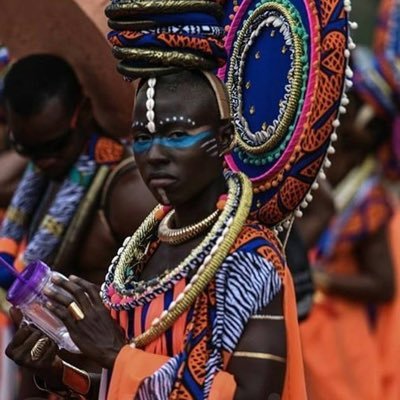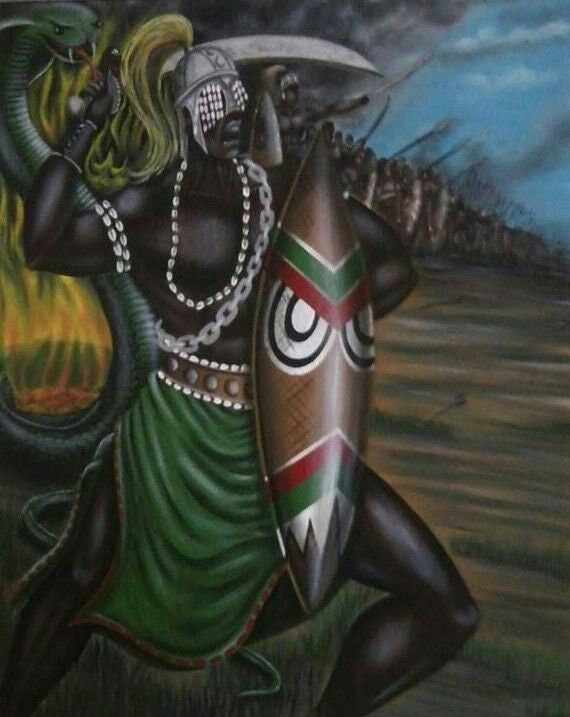
In Nigeria, Shango, god of thunder,
is the only deity worshipped in the Shango cult. Other Yoruba gods have their
own priests, societies, and cult centers (Forde 1951:29). In Trinidad, Shango
is only one of dozens of "powers," including fifteen or more Yoruba
deities, who are followed by persons engaged in "African work."
Olorun, the supreme god of the
Yoruba (Frobenius 1913:':198; Johnson 1921:26; Talbot 1926:II:29; Parrinder
1954:34), has not been transferred by name to Trinidad. Two other Yoruba gods,
Elefon and Obalufon (Bascom 1944:30), have been reinterpreted as "Eternal
Father" and Jesus in Trinidadian shango. Ifa, god of divination, is not
known to my informants in Trinidad. Frobenius (1913:I:229) observed that black
and white missionaries to the Yoruba created misunderstanding concerning the
Orisha Eshu by making him the equivalent of the Devil. He was told that Eshu
"... played many tricks; Edju made kindred peoples go to war; Edju pawned
the moon and carried off the sun; Edju made the Gods strive against themselves.
But Edju is not evil. He brought us the best of all there is, he gave us the
Ifa oracle; he brought the sun. But for Edju, the fields would be barren."
Bascom (1944:38) regards Eshu as a messenger of the orisha. Parrinder
(1949:67-68; 1953:30-31) found that Eshu may be used to protect from danger or
to cause harm to others.
According to Frobenius (1913:I:234), Eshu's abode was
an underground Ina (fire) or he lived in Inu (caverns) filled with fire in the
mountains. No sacrifice could be offered to him without fire, and every shrine
in his honor had to be purified by fire and ashes. A syncretism of Yoruba and
Christian elements is seen in beliefs and rituals associated with Eshu in the
shango cult in Trinidad. Eshu is paired with Satan, and many devotees believe
that he is capable only of evil deeds. Some informants hold that Eshu can
perform good as well as evil acts, but these persons advised against staying on
too friendly terms with him. At the beginning of a shango ritual, Eshu's food,
a calabash of water and a calabash of ashes, is brought into the palais while
one or more songs are sung asking him to leave the ceremony. The carrying of
the two calabashes outside the ritual area symbolizes the "dismissal"
of Eshu.

Shango, god of thunder and
lighting, has rivers for wives: Oya (the Niger river), Oshun, and Oba. In the
Trinidadian cult, Shango is invariably equated with St. John, Oya with St.
Catherine or St. Philomena, and Oshun with St. Anne or St. Philomena. I did not
encounter Oba, nor have I seen her name mentioned in the literature.
Ogun, ancient god of war, iron, and
the hunt, remains popular in southern Nigeria. No longer needed as a deity of
war, Ogun is still important to blacksmiths, hunters, and through an extension
of his authority, motor drivers (Parrinder 1953:25-26). Ogun, paired with St.
Michael, is a powerful spirit in the shango cult of Trinidad. Le Herisse and
Herskovits have shown that Sopona (Sopponna, Shankpanna, Shokpona, Sakpata) is
an earth god who has come in recent years to be regarded almost solely as the
smallpox deity (Le Herisse 1911:128; Herskovits 1938:ch.27; Parrinder 1949:51).
In Trinidad, Shakpana, who corresponds to St. Jerome, St. Francis, or Moses, is
thought of as a doctor.

Orisala (Orishala), known locally
under different names, including Obatala, is said in Nigeria to have been
closely associated with Olorun in the creation of the world. Also, he is
believed to punish those who violate his taboos by causing their children to be
albinos, dwarfs, or deformed persons (Johnson 1921:27; Talbot 1926:II:31;
Parrinder 1953:27). In Trinidad, Obatala is identified with St. Benedict.
Yemanja, daughter of Obatala and Odudua (not found in Trinidad), is the deity
of the river Ogu. She is called Emanja, Amanja, or Omanja in Trinidad and is
equated with St. Anne or St. Catherine. According to Yoruba myth, Orungan,
Yemanja's son, committed incest with her and 15 deities were born, including
Shango and Ogun (Talbot 1926:II:31; Parrinder 1949: 54, 55).
Osahin (Osayin, Osanyin), a Yoruba
god of medicine (Lucas 1948:153-74; Parrinder 1953: 36), known as Osain in
Trinidadian shango, is the equivalent of St. Francis and is called upon in
treating certain types of disease, especially illnesses caused by evil spirits.
Aja, a minor spirit in Nigeria (Lucas 1948:153 ff), is called Ajaja in Trinidad and corresponds to
Jonah or Moses. A least one shango priestess in Trinidad calls St. Peter by the
name of the Yoruba twin gods, Beji (Ibeji). Oromele, or St. Joseph, may be the
Trinidadian name for Oro (Parrinder 1953:35, 57); Erale, who is equated with
Moses or Jonah, may be the Yoruba god Erinle (Parrinder 1953: 30). Although
Oko, the farm god, is still popular in Nigeria (Parrinder 1953:24), none of my
informants mentioned this deity and I heard no songs in his honor at
ceremonies. A shango goddess in Trinidad variously known as Mother of the
Earth, Mama Laate, and Mother of All Nations, whose Catholic equivalents are
St. Veronica, Mother of Mount Carmel, and Eve (African name is said to be
Aiyakba), is not now an agricultural deity. Other alleged but untraced African
gods named by shangoists in Trinidad include: Omalale, Abacuso, Bookbiaba,
Bozeon, Olomene, Areasan, Olopelofon, and Zazep.
The elaborate mythology which
underlies and explains Yoruba religious beliefs and practices has disappeared
in Trinidad. As in some Brazilian batuques and Candombles (Bastide
1960:359-60), Catholic hagiography has taken the place of the old myths.
Question
After reading about the gods of Trinidad and Tobago, what are your thoughts and how does Shango in Trinidad differ from more popular religions such as Christianity and Hinduism?
References
FROBENIUS, LEO. 1913 The voice of
Africa. London, Hutchinson & Co. 2 vols.
IAN 1926 CENSUS The peoples of
Southern Nigeria. London, Oxford University Press. 3 vols. 1946, Part G (Census
of the Colony of Trinidad and Tobago), pp. xxiv, 12.
POPULA1961 Population by sex, age
group and race. In Preliminary Bulletin No. 1, 1960 Census of Population of Trinidad
and Tobago, pp. 2-3. April 19, 1961. 1961b Population by sex and religion. In
Census Bulletin No. 2, pp. 2-3, August 14, 1961
Comments
Post a Comment